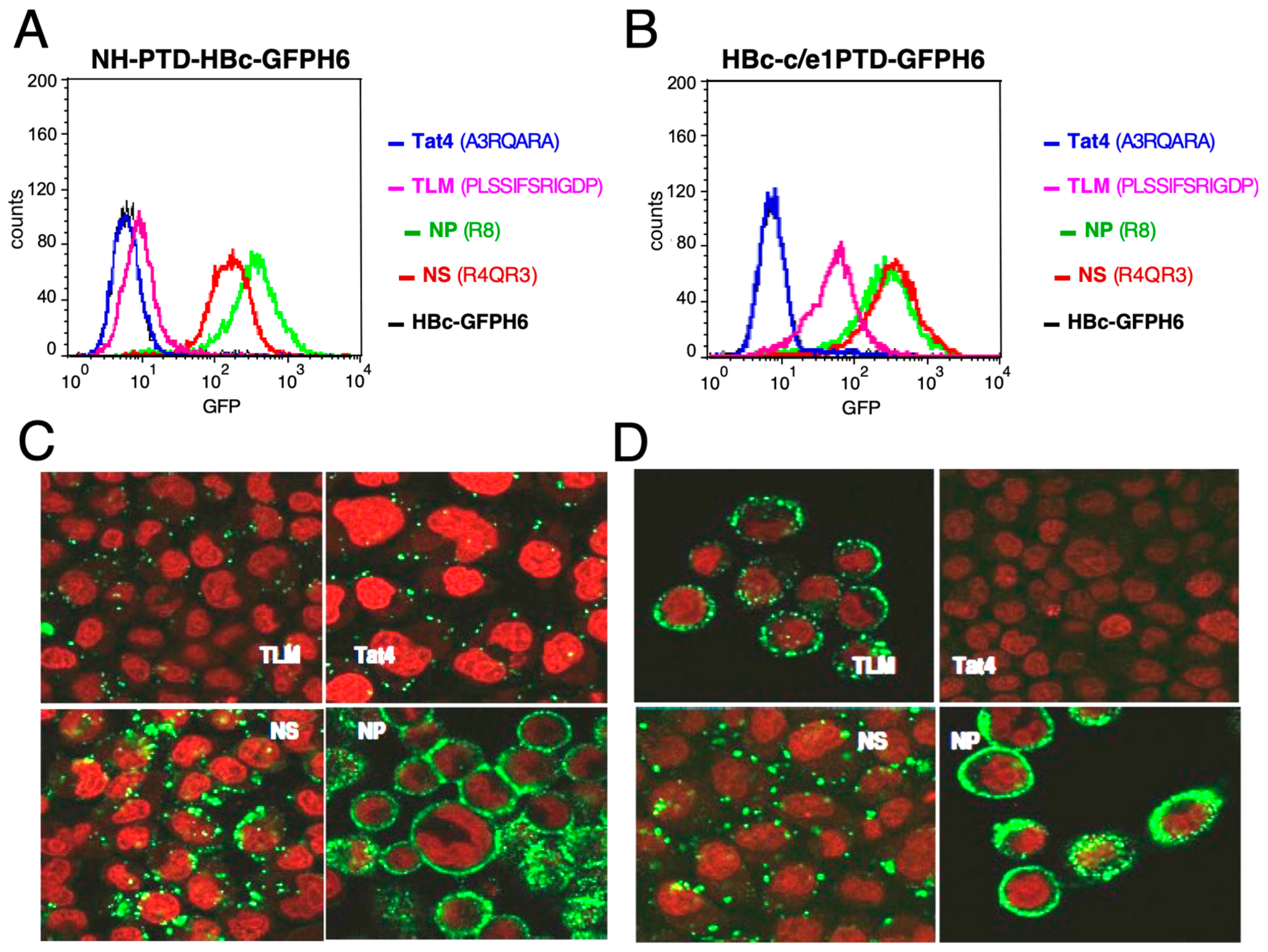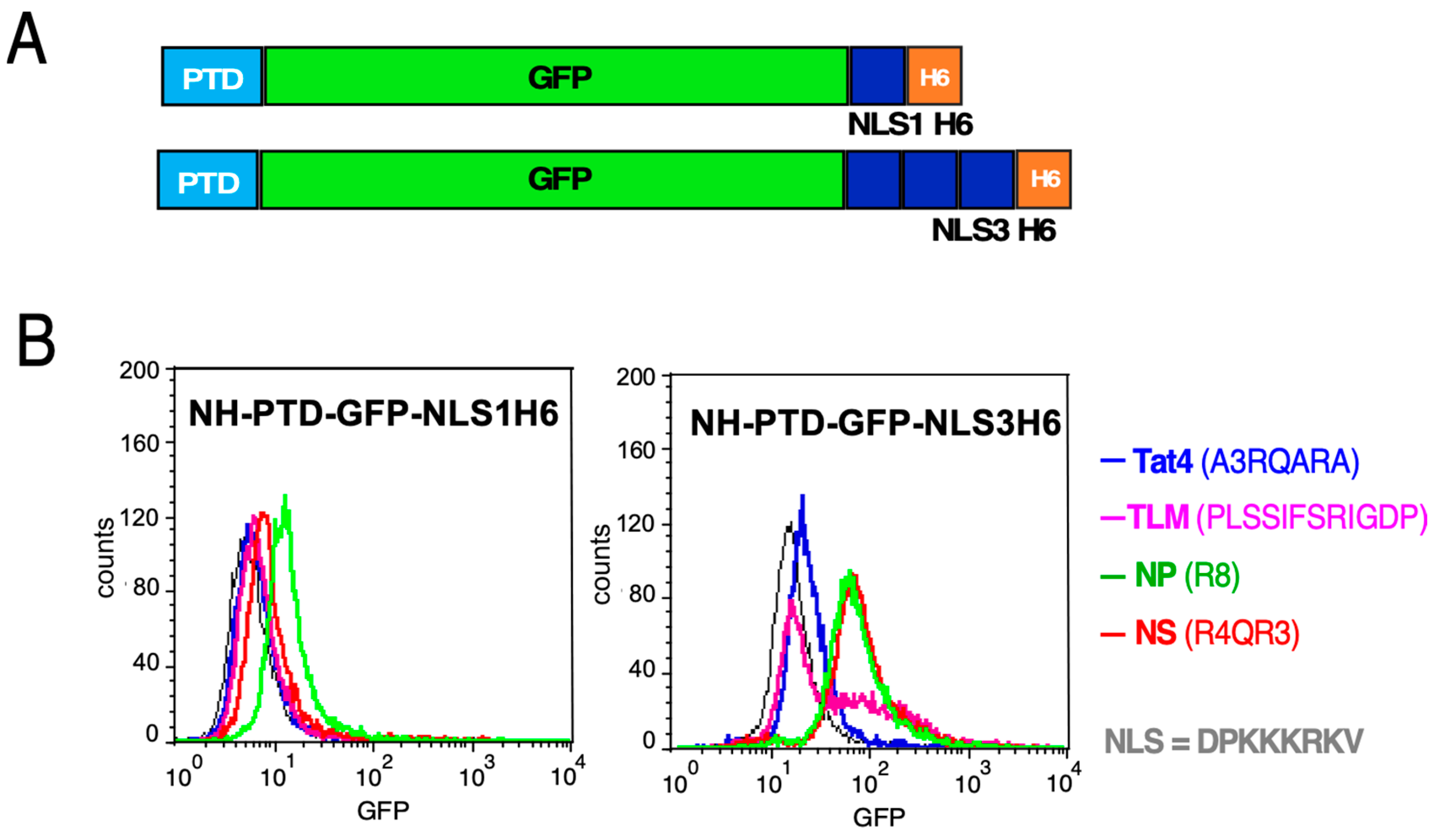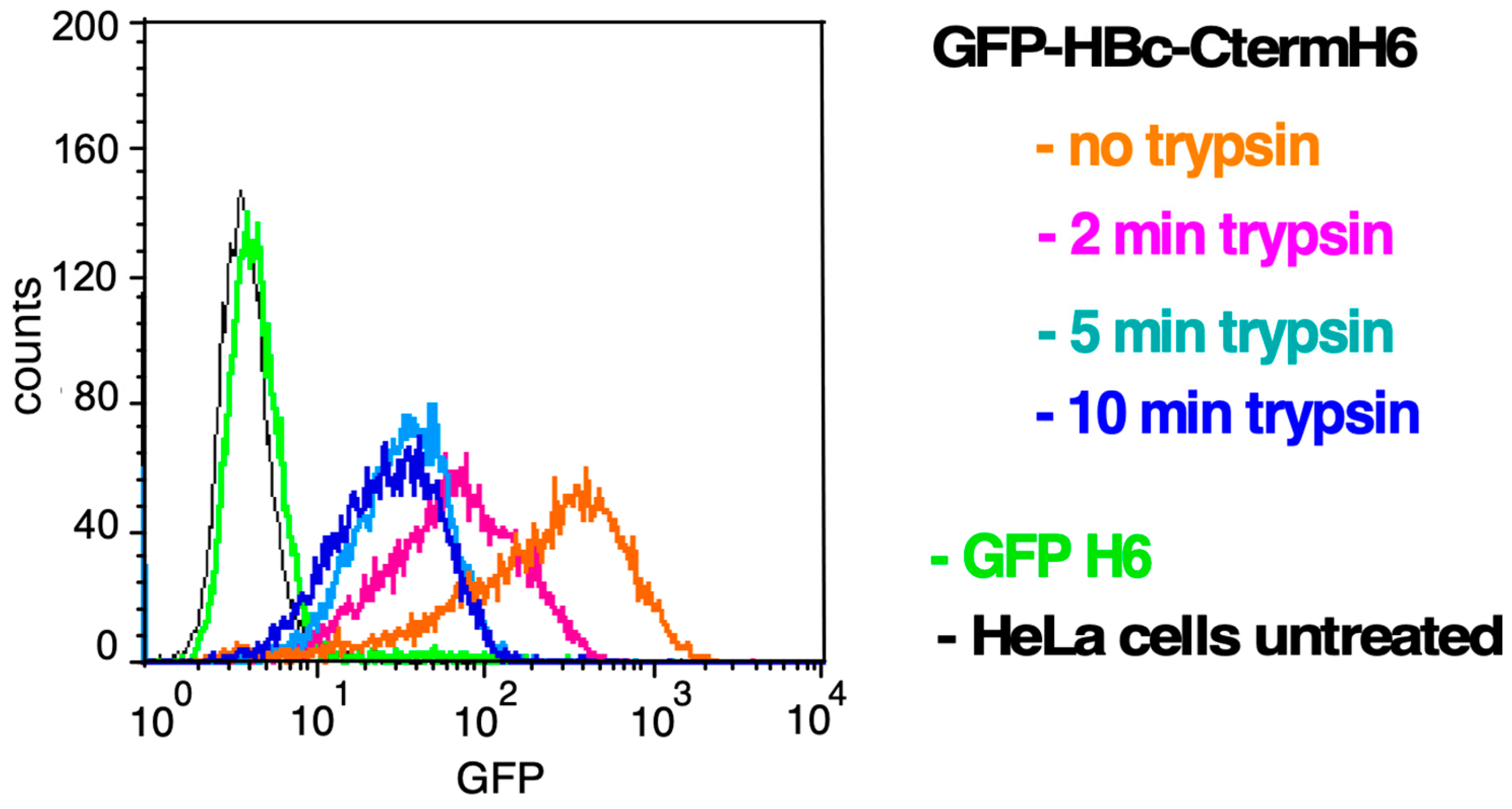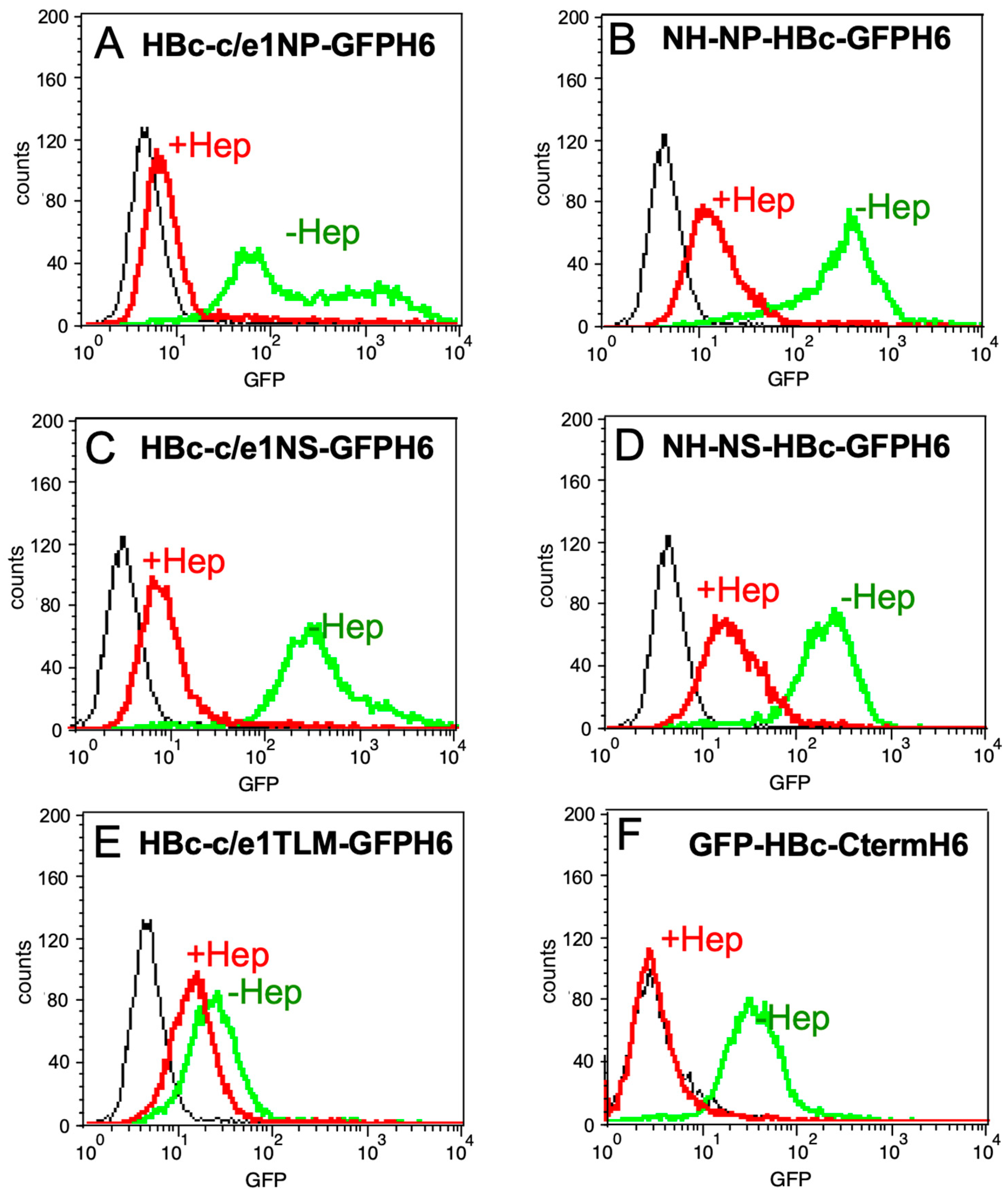Towards Cell-Permeable Hepatitis B Virus Core Protein Variants as Potential Antiviral Agents
Abstract
:1. Introduction
2. Experimental Procedures
2.1. Plasmid Constructs
2.2. Expression and Characterization of Fusion Proteins
2.3. Cell Culture and Transduction Protocol
2.4. Flow Cytometry
2.5. Fluorescence and Confocal Laser Scanning Microscopy
3. Results
3.1. Expression and Purification of Fluorescent PTD Fusion Proteins
3.2. Flow Cytometric Analysis of Cellular Uptake of Fusion Proteins
3.3. Analysis of Cell Uptake Using Confocal Microscopy
3.4. Effect of Insertion of a Nuclear Localization Signal (NLS) Sequence on Cellular Uptake of Fusion Proteins
3.5. A PTD-like Activity in the HBc-CTD
3.6. Influence of Heparin on the Binding of PTD- and HBc-CTD-Containing FPs to HeLa Cells
4. Discussion
4.1. Fusion Proteins with PTD in the Context of GFPH6, GFPNLS1H6, and GFPNLS3H6
4.2. Fusion Proteins with PTD in the Context of HBc-GFPH6
4.3. The HBc CTD as a Potential PTD
5. Conclusions
Supplementary Materials
Author Contributions
Funding
Data Availability Statement
Acknowledgments
Conflicts of Interest
References
- Rajoriya, N.; Combet, C.; Zoulim, F.; Janssen, H.L.A. How viral genetic variants and genotypes influence disease and treatment outcome of chronic hepatitis B. Time for an individualised approach? J. Hepatol. 2017, 67, 1281–1297. [Google Scholar] [CrossRef]
- Hepatitis B, WHO. 2023. Available online: https://www.who.int/news-room/fact-sheets/detail/hepatitis-b (accessed on 23 September 2023).
- Tu, T.; Budzinska, M.; Shackel, N.; Urban, S. HBV DNA Integration: Molecular Mechanisms and Clinical Implications. Viruses 2017, 9, 75. [Google Scholar] [CrossRef]
- Nassal, M. HBV cccDNA: Viral persistence reservoir and key obstacle for a cure of chronic hepatitis B. Gut 2015, 64, 1972–1984. [Google Scholar] [CrossRef]
- Yan, H.; Zhong, G.; Xu, G.; He, W.; Jing, Z.; Gao, Z.; Huang, Y.; Qi, Y.; Peng, B.; Wang, H.; et al. Sodium taurocholate cotransporting polypeptide is a functional receptor for human hepatitis B and D virus. eLife 2012, 1, e00049. [Google Scholar] [CrossRef]
- Ni, Y.; Lempp, F.A.; Mehrle, S.; Nkongolo, S.; Kaufman, C.; Fälth, M.; Stindt, J.; Königer, C.; Nassal, M.; Kubitz, R.; et al. Hepatitis B and D Viruses Exploit Sodium Taurocholate Co-transporting Polypeptide for Species-Specific Entry into Hepatocytes. Gastroenterology 2014, 146, 1070–1083.e6. [Google Scholar] [CrossRef]
- Niklasch, M.; Zimmermann, P.; Nassal, M. The Hepatitis B Virus Nucleocapsid—Dynamic Compartment for Infectious Virus Production and New Antiviral Target. Biomedicines 2021, 9, 1577. [Google Scholar] [CrossRef]
- Gallina, A.; Bonelli, F.; Zentilin, L.; Rindi, G.; Muttini, M.; Milanesi, G. A recombinant hepatitis B core antigen polypeptide with the protamine-like domain deleted self-assembles into capsid particles but fails to bind nucleic acids. J. Virol. 1989, 63, 4645–4652. [Google Scholar] [CrossRef]
- Birnbaum, F.; Nassal, M. Hepatitis B virus nucleocapsid assembly: Primary structure requirements in the core protein. J. Virol. 1990, 64, 3319–3330. [Google Scholar] [CrossRef]
- Wynne, S.A.; Crowther, R.A.; Leslie, A.G.W. The Crystal Structure of the Human Hepatitis B Virus Capsid. Mol. Cell 1999, 3, 771–780. [Google Scholar] [CrossRef]
- Heger-Stevic, J.; Zimmermann, P.; Lecoq, L.; Böttcher, B.; Nassal, M. Hepatitis B virus core protein phosphorylation: Identification of the SRPK1 target sites and impact of their occupancy on RNA binding and capsid structure. PLoS Pathog. 2018, 14, e1007488. [Google Scholar] [CrossRef]
- Khan, I.W.; Dad Ullah, M.U.; Choudhry, M.; Ali, M.J.; Ali, M.A.; Lam, S.L.K.; Shah, P.A.; Kaur, S.P.; Lau, D.T.Y. Novel Therapies of Hepatitis B and D. Microorganisms 2021, 9, 2607. [Google Scholar] [CrossRef]
- Beterams, G.; Nassal, M. Significant Interference with Hepatitis B Virus Replication by a Core-nuclease Fusion Protein. J. Biol. Chem. 2001, 276, 8875–8883. [Google Scholar] [CrossRef]
- Sun, Z.; Huang, J.; Fishelson, Z.; Wang, C.; Zhang, S. Cell-Penetrating Peptide-Based Delivery of Macromolecular Drugs: Development, Strategies, and Progress. Biomedicines 2023, 11, 1971. [Google Scholar] [CrossRef]
- Khairkhah, N.; Namvar, A.; Bolhassani, A. Application of Cell Penetrating Peptides as a Promising Drug Carrier to Combat Viral Infections. Mol. Biotechnol. 2023, 65, 1387–1402. [Google Scholar] [CrossRef]
- Timotievich, E.D.; Shilovskiy, I.P.; Khaitov, M.R. Cell-Penetrating Peptides as Vehicles for Delivery of Therapeutic Nucleic Acids. Mechanisms and Application in Medicine. Biochemistry 2023, 88, 1800–1817. [Google Scholar] [CrossRef]
- Fittipaldi, A.; Ferrari, A.; Zoppé, M.; Arcangeli, C.; Pellegrini, V.; Beltram, F.; Giacca, M. Cell Membrane Lipid Rafts Mediate Caveolar Endocytosis of HIV-1 Tat Fusion Proteins. J. Biol. Chem. 2003, 278, 34141–34149. [Google Scholar] [CrossRef]
- Schwarze, S.R.; Ho, A.; Vocero-Akbani, A.; Dowdy, S.F. In Vivo Protein Transduction: Delivery of a Biologically Active Protein into the Mouse. Science 1999, 285, 1569–1572. [Google Scholar] [CrossRef] [PubMed]
- Kim, M.; Kim, M.; Kim, H.Y.; Kim, S.; Jung, J.; Maeng, J.; Chang, J.; Lee, K. A protein transduction domain located at the NH2-terminus of human translationally controlled tumor protein for delivery of active molecules to cells. Biomaterials 2011, 32, 222–230. [Google Scholar] [CrossRef]
- Rádis-Baptista, G.; Campelo, I.S.; Morlighem, J.-É.R.L.; Melo, L.M.; Freitas, V.J.F. Cell-penetrating peptides (CPPs): From delivery of nucleic acids and antigens to transduction of engineered nucleases for application in transgenesis. J. Biotechnol. 2017, 252, 15–26. [Google Scholar] [CrossRef]
- Yang, J.; Tsutsumi, H.; Furuta, T.; Sakurai, M.; Mihara, H. Interaction of amphiphilic α-helical cell-penetrating peptides with heparan sulfate. Org. Biomol. Chem. 2014, 12, 4673. [Google Scholar] [CrossRef]
- Zhu, P.; Jin, L. Cell Penetrating Peptides: A Promising Tool for the Cellular Upta ke of Macromolecular Drugs. Curr. Protein Pept. Sci. 2017, 19, 211–220. [Google Scholar] [CrossRef]
- Brandenburg, B.; Stockl, L.; Gutzeit, C.; Roos, M.; Lupberger, J.; Schwartlander, R.; Gelderblom, H.; Sauer, I.M.; Hofschneider, P.H.; Hildt, E. A novel system for efficient gene transfer into primary human hepatocytes via cell-permeable hepatitis B virus-like particle. Hepatology 2005, 42, 1300–1309. [Google Scholar] [CrossRef] [PubMed]
- Vogel, M.; Vorreiter, J.; Nassal, M. Quaternary structure is critical for protein display on capsid-like particles (CLPs): Efficient generation of hepatitis B virus CLPs presenting monomeric but not dimeric and tetrameric fluorescent proteins. Proteins Struct. Funct. Bioinforma. 2005, 58, 478–488. [Google Scholar] [CrossRef] [PubMed]
- Zolotukhin, S.; Potter, M.; Hauswirth, W.W.; Guy, J.; Muzyczka, N. A “humanized” green fluorescent protein cDNA adapted for high-level expression in mammalian cells. J. Virol. 1996, 70, 4646–4654. [Google Scholar] [CrossRef] [PubMed]
- Oess, S.; Hildt, E. Novel cell permeable motif derived from the PreS2-domain of hepatitis-B virus surface antigens. Gene Ther. 2000, 7, 750–758. [Google Scholar] [CrossRef]
- Ho, A.; Schwarze, S.R.; Mermelstein, S.J.; Waksman, G.; Dowdy, S.F. Synthetic protein transduction domains: Enhanced transduction potential in vitro and in vivo. Cancer Res. 2001, 61, 474–477. [Google Scholar] [PubMed]
- Suzuki, T.; Futaki, S.; Niwa, M.; Tanaka, S.; Ueda, K.; Sugiura, Y. Possible Existence of Common Internalization Mechanisms among Arginine-rich Peptides. J. Biol. Chem. 2002, 277, 2437–2443. [Google Scholar] [CrossRef] [PubMed]
- Richard, J.P.; Melikov, K.; Vives, E.; Ramos, C.; Verbeure, B.; Gait, M.J.; Chernomordik, L.V.; Lebleu, B. Cell-penetrating Peptides. J. Biol. Chem. 2003, 278, 585–590. [Google Scholar] [CrossRef]
- Hodel, M.R.; Corbett, A.H.; Hodel, A.E. Dissection of a Nuclear Localization Signal. J. Biol. Chem. 2001, 276, 1317–1325. [Google Scholar] [CrossRef]
- Li, H.-C.; Huang, E.-Y.; Su, P.-Y.; Wu, S.-Y.; Yang, C.-C.; Lin, Y.-S.; Chang, W.-C.; Shih, C. Nuclear export and import of human hepatitis B virus capsid protein and particles. PLoS Pathog. 2010, 6, e1001162. [Google Scholar] [CrossRef]
- Eckhardt, S.G.; Milich, D.R.; McLachlan, A. Hepatitis B virus core antigen has two nuclear localization sequences in the arginine-rich carboxyl terminus. J. Virol. 1991, 65, 575–582. [Google Scholar] [CrossRef] [PubMed]
- Kann, M.; Sodeik, B.; Vlachou, A.; Gerlich, W.H.; Helenius, A. Phosphorylation-dependent Binding of Hepatitis B Virus Core Particles to the Nuclear Pore Complex. J. Cell Biol. 1999, 145, 45–55. [Google Scholar] [CrossRef] [PubMed]
- Yeh, C.T.; Liaw, Y.F.; Ou, J.H. The arginine-rich domain of hepatitis B virus precore and core proteins contains a signal for nuclear transport. J. Virol. 1990, 64, 6141–6147. [Google Scholar] [CrossRef]
- Mann, D.A.; Frankel, A.D. Endocytosis and targeting of exogenous HIV-1 Tat protein. EMBO J. 1991, 10, 1733–1739. [Google Scholar] [CrossRef] [PubMed]
- Rusnati, M.; Coltrini, D.; Oreste, P.; Zoppetti, G.; Albini, A.; Noonan, D.; d’Adda di Fagagna, F.; Giacca, M.; Presta, M. Interaction of HIV-1 Tat Protein with Heparin. J. Biol. Chem. 1997, 272, 11313–11320. [Google Scholar] [CrossRef] [PubMed]
- Vanlandschoot, P.; Van Houtte, F.; Serruys, B.; Leroux-Roels, G. The arginine-rich carboxy-terminal domain of the hepatitis B virus core protein mediates attachment of nucleocapsids to cell-surface-expressed heparan sulfate. J. Gen. Virol. 2005, 86, 75–84. [Google Scholar] [CrossRef]
- Hafner, A.; Brandenburg, B.; Hildt, E. Reconstitution of gene expression from a regulatory-protein-deficient hepatitis B virus genome by cell-permeable HBx protein. EMBO Rep. 2003, 4, 767–773. [Google Scholar] [CrossRef] [PubMed]
- Bleifuss, E.; Kammertoens, T.; Hutloff, A.; Quarcoo, D.; Dorner, M.; Straub, P.; Uckert, W.; Hildt, E. The translocation motif of hepatitis B virus improves protein vaccination. Cell. Mol. Life Sci. 2006, 63, 627–635. [Google Scholar] [CrossRef]
- Dietrich, L.; Rathmer, B.; Ewan, K.; Bange, T.; Heinrichs, S.; Dale, T.C.; Schade, D.; Grossmann, T.N. Cell Permeable Stapled Peptide Inhibitor of Wnt Signaling that Targets β-Catenin Protein-Protein Interactions. Cell Chem. Biol. 2017, 24, 958–968.e5. [Google Scholar] [CrossRef]
- Li, Q.; Hao, X.; Zaidi, S.S.A.; Guo, J.; Ren, X.; Shi, C.; Zhang, W.; Feng, Y. Oligohistidine and targeting peptide functionalized TAT-NLS for enhancing cellular uptake and promoting angiogenesis in vivo. J. Nanobiotechnol. 2018, 16, 29. [Google Scholar] [CrossRef]
- Ragin, A.D.; Morgan, R.A.; Chmielewski, J. Cellular Import Mediated by Nuclear Localization Signal Peptide Sequences. Chem. Biol. 2002, 9, 943–948. [Google Scholar] [CrossRef] [PubMed]
- Ragin, A.D.; Chmielewski, J. Probing essential residues for cellular uptake with a cationic nuclear localization signal sequence. J. Pept. Res. 2004, 63, 155–160. [Google Scholar] [CrossRef] [PubMed]
- Vogel, M.; Diez, M.; Eisfeld, J.; Nassal, M. In vitro assembly of mosaic hepatitis B virus capsid-like particles (CLPs): Rescue into CLPs of assembly-deficient core protein fusions and FRET-suited CLPs. FEBS Lett. 2005, 579, 5211–5216. [Google Scholar] [CrossRef]
- Beterams, G.; Böttcher, B.; Nassal, M. Packaging of up to 240 subunits of a 17 kDa nuclease into the interior of recombinant hepatitis B virus capsids. FEBS Lett. 2000, 481, 169–176. [Google Scholar] [CrossRef] [PubMed]
- Rothenhäusler, B.; Knoll, W. Surface–plasmon microscopy. Nature 1988, 332, 615–617. [Google Scholar] [CrossRef]
- Steiner, G.; Sablinskas, V.; Hübner, A.; Kuhne, C.; Salzer, R. Surface plasmon resonance imaging of microstructured monolayers. J. Mol. Struct. 1999, 509, 265–273. [Google Scholar] [CrossRef]







| PTD | NH-PTD-HBc-GFPH6 | HBc-c/e1 PTD-GFPH6 | NH-PTD-GFPH6 |
|---|---|---|---|
| TLM: PLSSIFSRIGDP | NH-TLM-HBc-GFPH6 | HBc-c/e1 TLM-GFPH6 | NH-TLM-GFPH6 |
| Tat4: A3RQARA | NH-Tat4-HBc-GFPH6 | HBc-c/e1Tat4-GFPH6 | NH-Tat4-GFPH6 |
| NS: R4QR3 | NH-NS-HBc-GFPH6 | HBc-c/e1NS-GFPH6 | NH-NS-GFPH6 |
| NP: R8 | NH-NP-HBc-GFPH6 | HBc-c/e1NP-GFPH6 | NH-NP-GFPH6 |
Disclaimer/Publisher’s Note: The statements, opinions and data contained in all publications are solely those of the individual author(s) and contributor(s) and not of MDPI and/or the editor(s). MDPI and/or the editor(s) disclaim responsibility for any injury to people or property resulting from any ideas, methods, instructions or products referred to in the content. |
© 2024 by the authors. Licensee MDPI, Basel, Switzerland. This article is an open access article distributed under the terms and conditions of the Creative Commons Attribution (CC BY) license (https://creativecommons.org/licenses/by/4.0/).
Share and Cite
Bendahmane, S.; Follo, M.; Zhang, F.; Linhardt, R.J. Towards Cell-Permeable Hepatitis B Virus Core Protein Variants as Potential Antiviral Agents. Microorganisms 2024, 12, 1776. https://doi.org/10.3390/microorganisms12091776
Bendahmane S, Follo M, Zhang F, Linhardt RJ. Towards Cell-Permeable Hepatitis B Virus Core Protein Variants as Potential Antiviral Agents. Microorganisms. 2024; 12(9):1776. https://doi.org/10.3390/microorganisms12091776
Chicago/Turabian StyleBendahmane, Sanaa, Marie Follo, Fuming Zhang, and Robert J. Linhardt. 2024. "Towards Cell-Permeable Hepatitis B Virus Core Protein Variants as Potential Antiviral Agents" Microorganisms 12, no. 9: 1776. https://doi.org/10.3390/microorganisms12091776






